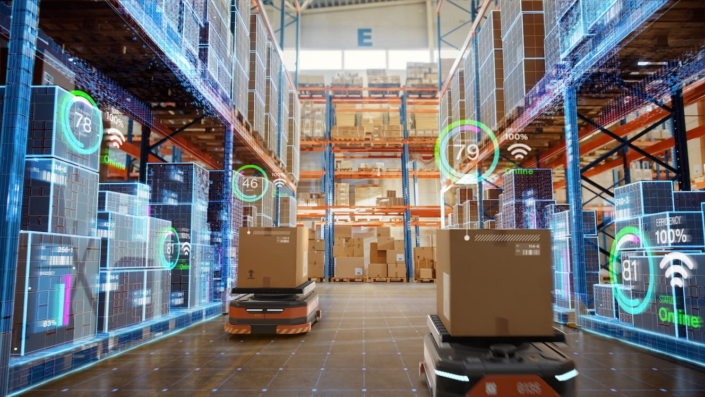Supply chain management requires the coordination of many moving parts. To maximize efficiency, businesses need to use people, processes, and technology efficiently. Just as importantly, they need to be ready for possible disruptions: labor strikes, supplier shutdowns, shipping bottlenecks, and more.
Artificial intelligence (AI) can help organizations achieve both efficiency and preparedness. This technology transforms supply chains for the better, leading to lower costs, greater visibility, and happier end customers.
Explore EasyPost’s newest tool, Luma, to learn how to harness the power of AI in your parcel shipping strategy.
What is AI in supply chain management?
In supply chain management, AI tools are used to quickly process large datasets, spot trends and patterns, automate complex tasks, and inform a business’s logistics strategy in everything from production to distribution.
Before going any further, let’s review a few definitions:
- Artificial intelligence (AI) is the broad field of creating systems that can mimic human intelligence, including reasoning, problem-solving, and decision-making.
- Machine learning (ML) is a subset of AI that allows computers to learn patterns from data and make predictions or decisions.
- Generative AI is a subset of artificial intelligence that creates new content by learning patterns from existing data.
Since ChatGPT’s 2022 release sparked a widespread interest in generative AI, many industries have begun adopting AI tools.
In a 2025 survey, 78% of respondents said their organizations use AI in at least one business function—up from 55% in the 2023 survey.
While many of these companies are comfortable integrating AI into their IT, marketing, and sales functions, they’ve been slower to use AI in their supply chains. However, more and more businesses are realizing that to keep up with customer demand and survive future disruptions, they need to be using AI.
How does AI in the supply chain work?
AI can be used to automate and streamline many supply chain functions, including forecasting, order fulfillment, and contingency planning.
The key to success? Accurate data.
When businesses train AI systems on accurate, up-to-date data, those systems can sort through information and surface insights that non-AI systems—and even experienced supply chain professionals—might not see. This leads to smarter decision-making across every logistics function.
Let’s take a look at several uses for AI in supply chain management:
- Demand forecasting. AI analyzes historical sales data, market trends, and external factors like weather or economic shifts to predict future demand more accurately. This helps businesses prevent stockouts or overstocking, keeping inventory levels just right.
- Route planning. Managing your own fleet? AI-powered tools can process traffic patterns, weather conditions, and delivery schedules to determine the fastest, most efficient routes.
- Procurement. AI makes it simple to choose suppliers by analyzing pricing, reliability, and delivery performance, making sure businesses get the best deals with minimal risk.
- Inventory tracking. Supply chain AI tools often integrate with RFID and IoT sensors to provide real-time inventory visibility across multiple locations. By eliminating manual scanning, organizations reduce errors and prevent stock discrepancies.
- Warehouse design. Some businesses are using AI-driven simulations to test different warehouse layouts and workflows, discovering new ways to maximize storage space and efficiency.
- Picking and packing. AI-powered algorithms improve picking speed and accuracy by guiding workers to the most efficient paths. When paired with robots, AI can even automate the picking process entirely! When it comes to packing, AI algorithms can suggest the best-sized boxes to minimize packaging waste. AI-powered vision systems add an extra layer of quality control by evaluating orders for accuracy and flagging damaged products.
- Shipping. AI solutions like Luma evaluate cost, speed, and reliability across multiple carriers to select the best shipping option for each order. This allows businesses to strike a perfect balance between cost savings and customer satisfaction.
- Detecting disruptions. AI can continuously monitor supply chain data to detect potential risks—like supplier delays or geopolitical events—and suggest solutions before problems escalate. With AI-driven simulations, organizations can model “what-if” scenarios, testing the impact of changes before making real-world decisions.
It’s important to keep in mind that AI works best when paired with human expertise. Rather than attempting to replace supply chain experts with AI, businesses should use AI as a strategic advisor that helps humans work more efficiently.
How AI is transforming supply chain operations
In the past, supply chain processes were largely manual. In warehouses, workers walked for hours a day picking products, while others used their best judgment to choose the right box sizes for packing. Businesses negotiated with shipping carriers one-on-one, locked in rates, and spent months building integrations with carrier systems. And the list goes on.
Today, automation is changing the game—and AI is playing a major role in the transformation, making supply chains faster, smarter, and more resilient.
AI-powered warehouse automation, quality control, inventory tracking, and shipping are minimizing errors and speeding up fulfillment, while advanced analytics provide insights that help businesses make better decisions.
Whether it’s cutting costs, improving delivery speed, or enhancing visibility, AI is reshaping supply chain management into a more data-driven, agile process.
Learn more about the future of supply chain technology
Benefits of AI in supply chain management
Using AI for supply chain optimization has many benefits, including lower costs, better decision-making, and greater resilience.
Lower costs
Adopting AI in supply chain management helps you cut costs in ways that add up fast.
Smarter demand forecasting reduces excess inventory, so you’re not tying up cash in products that just sit in a warehouse (or running out of popular items and losing sales). AI-driven carrier selection ensures you’re always using the most cost-effective shipping option. AI-powered quality control can catch packaging mistakes before they result in returns or reshipments. And warehouse automation—like AI robots that help with picking and packing—means fewer labor hours spent on repetitive tasks.
Real-time insights for better decision-making
The right AI tools help you make smarter decisions by analyzing real-time data, rather than relying on guesswork or outdated trends.
Take parcel shipping, for example. AI can analyze past shipping data—carrier reliability, transit times, and costs—to automatically choose the best service for each order. If one carrier has been consistently missing delivery windows in a certain region, AI spots the pattern and suggests a better alternative before it becomes a major problem. These insights keep your operations efficient and your customers happy.
AI’s decision-making capabilities aren’t limited to parcel shipping. As long as you can collect accurate data, whether that’s through barcodes, RFID, IoT, or other supply chain technology, AI can provide recommendations and even implement them automatically.
Supply chain visibility and resilience
AI gives you full visibility into your supply chain, so you’re never caught off guard by disruptions. Real-time tracking powered by AI lets you monitor inventory, shipments, and supplier performance across multiple locations. If a key supplier has a sudden delay, AI can quickly identify backup options and suggest the best alternative.
During major disruptions—like weather events or port congestion—AI-driven simulations can help you model different responses and choose the one that keeps your business running with minimal impact.
Customer satisfaction
When they order products online, customers expect affordable shipping fees, fast deliveries, real-time tracking updates, and undamaged packages. AI makes it all possible by optimizing order fulfillment from start to finish.
Smarter inventory management means that high-demand products are always in stock, while AI warehouse automation speeds up picking, packing, and shipping. AI also improves accuracy; by selecting the fastest carrier and reducing packing mistakes, it ensures that customers get exactly what they ordered, on time and intact.
In addition to improving behind-the-scenes logistics processes, AI also helps with customer interactions. AI customer service chatbots can quickly handle delivery inquiries, saving your team time while keeping customers in the loop. While live representatives should be available for complicated or time-sensitive questions, chatbots are ideal for handling common questions like “When will my package arrive?” and “How can I track my package?”
Greater sustainability
AI helps your business reduce waste and lower its environmental footprint without sacrificing efficiency. This benefit comes into play throughout the supply chain.
By optimizing shipping routes and consolidating deliveries, AI-powered logistics tools cut down on fuel consumption and emissions. AI can also help reduce packaging waste by recommending the right box size for each order, preventing material waste. And predictive analytics help you avoid overstocking, reducing the number of unsold products that end up in landfills.
Whether you’re looking to cut carbon emissions or save on materials, AI-driven efficiency goes hand-in-hand with sustainability.
What are the problems with AI in supply chain?
It’s important to be aware of the potential challenges and risks you might face when incorporating AI into your supply chain. With proper planning, these risks won’t derail your operations.
Complex systems
AI can make supply chain operations more efficient, but implementing AI solutions isn’t always simple. Many AI tools require integration with existing software, warehouse systems, and supplier networks; this is especially challenging for businesses with legacy systems.
Another potential issue? If an AI model isn’t properly trained or optimized for your specific supply chain needs, it could generate recommendations that don’t align with real-world constraints.
Data availability and accuracy
AI is only as good as the data it’s trained on. If your supply chain data is incomplete, outdated, or inconsistent, AI-driven insights and predictions might be unreliable.
For example, if historical sales data doesn’t reflect recent market shifts, AI could overestimate demand, leading to overstocking. Similarly, errors in tracking data—like incorrect inventory counts or mislabeled shipments—can cause AI systems to make costly mistakes.
For the best results, make sure to invest in high-quality data collection and ensure that AI models are continuously updated with accurate information.
Security issues
AI-powered supply chains rely on vast amounts of data, making them potential targets for cyberattacks. Hackers could exploit vulnerabilities in logistics platforms to manipulate inventory data, disrupt shipments, or access sensitive customer information. Strong cybersecurity measures, including encryption, access controls, and regular security audits, are essential to keep your data safe.
Luma: AI-driven shipping intelligence
Last-mile parcel delivery is one of the most expensive parts of the supply chain. But parcel shipping isn’t just a cost center—it’s your chance to impress customers, provide a great delivery experience, and convince them to make another purchase.
EasyPost Luma is an AI shipping tool that saves businesses money without sacrificing delivery time or reliability. Trained on the data from billions of historical shipments, Luma surfaces insights and makes recommendations that help shippers refine their strategies.
- Luma Insights provides visibility into your parcel shipping strategy from the first to the last mile.
- Luma Advisor offers recommendations to improve your carrier mix, save money, and choose the fastest delivery methods.
- Luma Select automatically applies the recommendations offered by Luma Advisor to purchase best-fit shipping labels.
Ready to explore the role of artificial intelligence in supply chain management?
Smarter shipping starts here
Between rising carrier rates and customers who demand fast, cheap delivery, parcel shipping can be complex and costly. The EasyPost suite of shipping APIs simplifies things. With EasyPost, you can easily integrate with carriers, generate labels, access built-in rate discounts, and more. When you layer on the power of an AI-driven shipping engine, you unlock even more time and cost savings.


